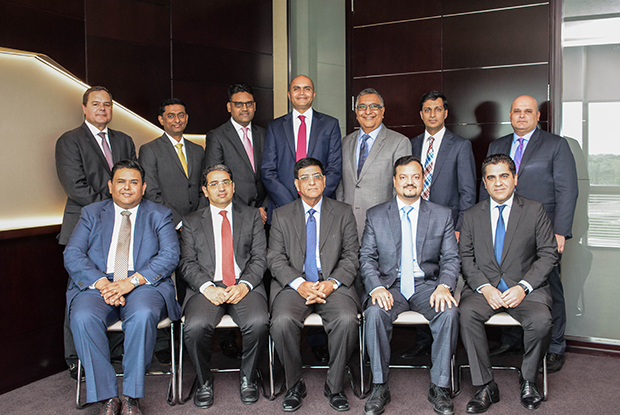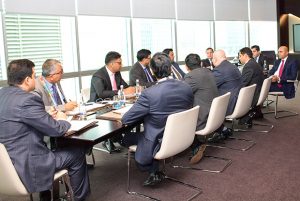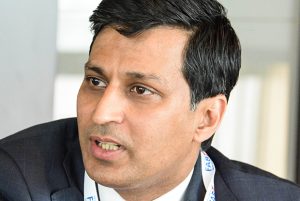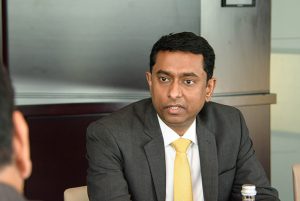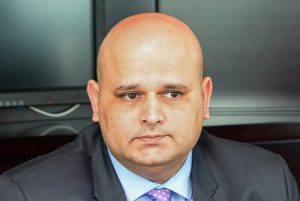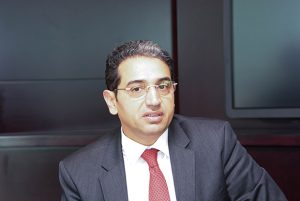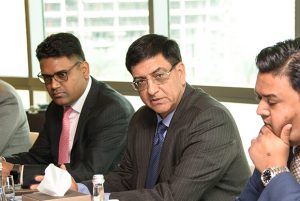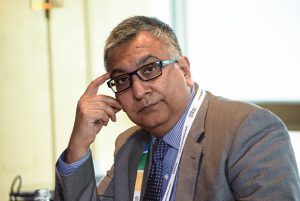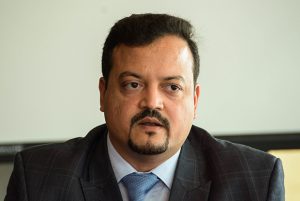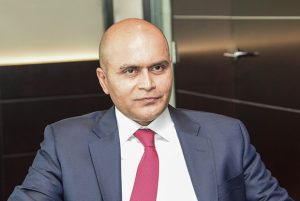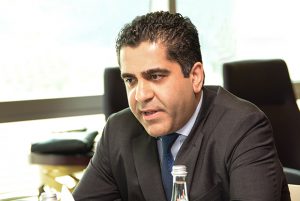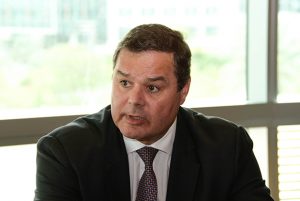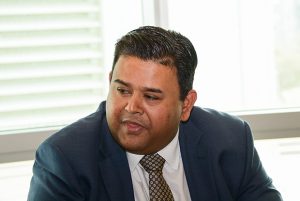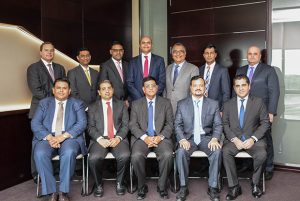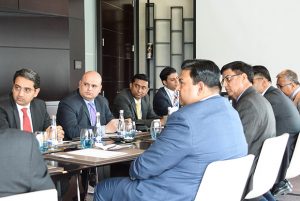Affected by global trends as well as regional challenges, Mena trade continues its journey through times of change. GTR gathered some of the region’s trade leaders to discuss how their business is transforming, whether SMEs are presenting new opportunities, and where banks and clients are placed in a growing and increasingly complex fintech landscape.
Roundtable participants
- Haroon Anwar, head of transaction banking, Emirates Islamic Bank
- Santosh Attery, executive director, trade product management, First Abu Dhabi Bank
- Maninder Bhandari, director, Derby Group (chair)
- Haytham Elmaayergi, global head of transaction banking, Abu Dhabi Islamic Bank
- Huny Garg, head of trade and supply chain, Swift
- Rahul Jayakar, head of trade, Noor Bank
- Bertie Lombard, head of corporate finance, National Bank of Fujairah
- Vineet Munot, head of transaction banking, National Bank of Bahrain
- Birju Sanghrajka, managing director and head of trade, Africa and Middle East, Standard Chartered Bank
- Sanjay Sethi, global head of transaction banking, Bank ABC
- Mritunjay Singh, lead, trade product management, trade finance, ADCB
- Sunil Veetil, regional head of trade and receivables finance, Mena and Turkey, HSBC
Bhandari: Let’s start by taking a macro perspective on trade and trade finance. To what extent has business changed compared to previous years?
Garg: From a statistics point of view, letter of credit issuance volumes for the region have been falling just like the rest of the world – last year volumes declined by 2.6%. In some markets there has been a drop in documentary trade volumes by over 10% in 2018. Some of it has to do with the actual flow of goods in the region and the decline in commodity prices, all of which have impacted trade flows. But in general, documentary trade finance among corporates, which was the primary mode of international trade 10 years ago, is declining. We see a lot more deals happening on the credit insurance side, and more appetite on the open account side, even in the commodities business. If you look at open account payments, for which MT103s are a good proxy, transaction numbers have gone up by 8% in 2018. Those trends are likely to continue.
Anwar: There is also a good push that has come from credit insurance. They are reaching out to more corporate clients in this region and are offering some solutions which they’ve relied heavily on banks to distribute in the past. So people are shifting from documentary trade to alternative ways of credit enhancement.
Veetil: A key trend we are seeing in the Middle East is that businesses, especially in the UAE, have been looking for alternative markets to expand. There is a lot of expansion happening by these businesses into, say, Africa or other countries in the Middle East, or even Asia. It is all about diversifying your business across economies to reduce concentration risk.
Sethi: What I am hearing from corporate clients is that their operational scope in GCC countries is plateauing. A slowdown of incremental business from Saudi, Oman, etc is making it more urgent for every large corporate to expand its outreach to surrounding geographies and territories. They are moving further out to the Levant, as well as North Africa, and from there into Sub-Saharan Africa. As a consequence, I am finding that the demand for our banking capabilities in North Africa and the Levant countries is increasing as corporates balance the need for outreach with the risk of doing business in these geographies, leading to an increase of volumes for us.
Sanghrajka: Everybody agrees that the global economy is in a wobbly space right now. As a result, while volumes dipped towards the end of last year, we have started seeing volumes coming back. When you dig deeper and look at where the volumes are coming from and going to, we see that trade between, say, the Middle East and traditional markets like India is still happening, but new corridors like Korea are opening and growing quite fast.
We have also seen an increased appetite from non-traditional investors for the trade asset class. So, as a bank, we are aggressively selling trade assets. Traditionally there was a requirement or prestige around growing your balance sheet every year, but it is now about churning that balance sheet and being able to distribute assets effectively.
Lombard: I see two drivers for the lower trade volumes. One is the global economy, and what is going on between the US and China at the moment. As a result of that, a lot of the economies are on pause. There is some hesitation.
The other aspect that is more specific to our region is our own geopolitical situation. Unfortunately, we are involved in areas of conflict, and that costs money. If we resolve those issues, how does it then uplift the market? This market, the UAE and the GCC market, has come out of its heyday, and the transition to the ordinary is going to take a bit of time. It’s also going to shake out those who are inefficient, those who don’t have the capacity to change, and the anxiety that comes with the transition is what we are feeling in the market at the moment.
Attery: Today we operate in an environment where we can’t isolate ourselves from any global events, be it Brexit, trends towards regionalisation of trade, the US-China trade spat, etc. Hence it is obvious that Mena is impacted by these headwinds. However, on the positive side, we do have initiatives like China’s Belt and Road where huge amount of investments are coming in.
About 4,000 onshore Chinese companies are based here in the UAE and there are a number of companies who have invested close to US$1bn, spurring the economic activity. There are also conscious efforts in building the connectivity and partnership between China and the UAE, which will help build the volume to a great extent and alleviate the impact of some of the macro trends.
Munot: To the point around low credit and low trade volumes: this is cultural. Banks are driving a bit of change by continuously approaching clients to structure financing. There is an element of moving clients towards a better structure, to get a better return. That is one thing that stands out.
The second thing in terms of the flows is that, if we look at trade, it is an economic issue, driven by government spending. This spend is happening in infrastructure, and hence you see most of the export credit agency funding in the last couple of years significantly growing on the back of this infrastructure. There is still much potential to grow, especially in Saudi Arabia. The flows are only going to get stronger, especially in the context where Qatar is out of the traditional GCC flows.
Singh: Mena is increasingly becoming important for the opportunities it presents specifically in the context of the Asia-Africa corridor. Better yielding opportunities are driving this change. From a bank’s point of view, what is important is that there is obviously increased appetite on the large corporate side. We see a lot more transactions happening. Even though the volumes are going down, a lot of open account financing is really taking shape in the large corporate space.
Mid-sized corporates is where I really see the problem, because banks are scaling down their appetite. And then there are the SMEs, which have always been underserviced. So there is growth, but it is very selective. There are headwinds in the geopolitical situation around sanctions, which don’t help. So mixed messages, but we obviously pick up where the opportunity really lies and focus on that.
Bhandari: What do you do for SMEs to ease their pain?
Elmaayergi: For us, the SME sector is a big play. The market is shifting dramatically from pure financing to structured financing. And the way everybody is looking at SMEs now has changed. The overdraft days are gone, and now we are looking at, who are you dealing with, can I give you receivables finance seeing as you are working with a big anchor, can I give you export finance because you are exporting to a country I’m comfortable with? I’m not going to give you just an overdraft; I need to see your flow.
So the story is different now, and I think SMEs understand that there is no free lunch. It has to be a genuine flow, and it has to be the full package.
Sanghrajka: Shying away from SMEs is not the answer. Many banks had challenges with the SME segment a few years ago and have generally recalibrated their risk on that segment.
Supply chain finance is the answer. The traditional way of doing supply chain finance, connecting buyers and anchors, is great. But when you overlay it with technology, you are able to do even more. You can use things like artificial intelligence to understand the probability of default on a portfolio of names, or look at an invoice to potentially do deep-tier financing. The technology is available today. Is it widely commercialised? Absolutely not. Are there use cases for it? Yes. But it is going to have to be a collaboration.
If you look at what is happening in Europe and the big projects in trade digitisation, be it Voltron or Marco Polo, banks are coming together with fintechs to try and solve problems. That needs to extend to this region as well.
Bhandari: From a corporate perspective, it is fantastic that the banks are collaborating. But from an on-the-ground reality perspective, what should a corporate be looking for? When I drew up a list of fintech firms, I had 45 names. As a corporate, where should I be going?
Singh: There is a multitude of choices of fintechs, and therefore the choice for banks becomes overwhelming. What is important is to get the SMEs the funding that is much needed. In India, there are three entities providing a marketplace for transactions. Various advisers can bid for those transactions and therefore drive the pricing to the right levels from the corporate’s perspective. It also provides risk mitigation by checking the genuineness of the transaction and by giving you ownership of that receivable with the regulatory authorities. We have done work to promote that model. There is no other way to do it.
Anwar: The acceptance of corporates to show transparency on these platforms has, in my view, not been very forthcoming. They still prefer the old-fashioned way of banks asking minimum questions and providing them with the limits they need to do business.
Where I see the opportunity is if I have a handful of banks blessing a fintech company or platform and encouraging their SMEs or corporates to take part. I have seen this increasing trend where no bank wants to be the sole bank any more. The days of saying ‘I want everything’ are over, and the clients want at least two or three banks. Fintech can play a huge part in that roadmap.
Attery: There is definitely a gap in SME funding, and I see that as an opportunity. Banks are uniquely placed at an advantage to solve the problem. To be able to do this one has to not just look at banks and SMEs, but also develop engagement from their counterparties and the entire ecosystem, such as the port authorities, customs, VAT authorities, etc, and create an ecosystem for all stakeholders to operate. This will bring about a lot of transparency in the system and build more confidence among banks to go ahead and fund the SMEs. This is also something we would want to achieve through UAE Trade Connect.
Veetil: One key thing that is critical in any economy is to have a robust regulatory framework around bankruptcy. The region’s governments, such as the UAE and Saudi Arabia, have made significant strides in this area, with the introduction of bankruptcy laws. This, alongside establishing strong credit bureaus, are necessary to support financial institutions to serve the region’s businesses more effectively. Because there is more work to do, this is also where the fintechs are coming in and trying to fill the gap.
Garg: There are some positive market developments, like the introduction of VAT, that improves the discipline amongst SMEs. People are more serious when there is an invoice to be issued, because there is a tax implication. But there is even more trust when they are sending invoices that can be verified using technology.
When banks come together to collaborate on an initiative, the primary effort is to find data that everybody can trust. Ultimately, banks will have to come together to create a solution that is inclusive in scope, whether local or international.
There are about 20 international trade finance-focused fintech initiatives. However, not more than two or three have gone beyond the proof of concept or pilot stage. There is usually a big announcement, but you don’t hear anything after that. The challenge is that, because there are five banks collaborating here and seven banks collaborating there, many have not achieved scale. We might see some consolidation in the next 24 months or an initiative taking a clear lead so that the industry can focus on scaling a solution.
Lombard: The rules of engagement have changed dramatically. For a long time we have been in a situation where the information that we get is asymmetrical. Obviously 2015 was a challenging year for SMEs in this market, and one of the fundamental reasons was that our decisions were based on information that was so insufficient and flawed. I see fintech starting to reshape that data, which allows us to make better decisions and make the selection process more robust.
But we also have to change the behaviour of the customer. Banks have had to change their behaviour through IFRS 9, but I see no pressure on the customer to do the same. That is going to be one of the bigger challenges for us moving ahead. The notion of building an SME base in a non-hydrocarbon-reliant economy is a great one. The cynic in me says, well, as soon as oil goes to US$80 again, all bets are off, and we will go back to the old model.
Elmaayergi: From the Islamic perspective, Islamic banks have to really start being creative to be able to compete with conventional banks, because we have typically been famous for the longer turnaround time or a process that an average treasurer may not understand. We have to innovate to make it look like the conventional while being compliant. The only problem is that from the long list of fintechs, I’m not sure which one will be a main revenue generator for a bank. It is a bit tricky. That is a challenge in the market.
It makes us continue as usual, and we leave fintech to live outside. While a marriage of fintechs and banks is all good news, there is nothing mainstream. It would be a good space for an Islamic bank to be in: we need to find those fintechs, incorporate them, get them to help us compete with conventional banks, because we have double the growth rate. So it is a bit of a dilemma now, and as we stand there is fatigue in the market.
Bhandari: Why has this region not moved faster when it comes to fintech?
Veetil: Things are happening in this part of the world. Governments are very actively propagating technology and automation. Dubai has formed a blockchain committee, Bahrain has got a fintech hub now. These are only two examples. They may have only just started, whereas by comparison, the US, Asia and the UK started five or seven years back, but we cannot underestimate that the region will catch up very quickly.
Sanghrajka: Five years after the financial crisis, supply chains were still in bad shape. There were 39-40 million fewer jobs supporting global supply chains. The economy is in a pretty interesting place right now: the same companies are now saying, ‘we would like to see stability in our supply chain’. Yes, it is the multinationals in the OECD markets who are signing up to fintech platforms, but their suppliers are in our region, and we are seeing them being asked to join supply chain finance programmes. So whether we believe the region is behind or not, our clients are getting exposed to global platforms.
The banks have the clients and the data, the fintechs have the platform. So we have to come together. The big challenge is the cross-border nature of it, as regulators come in and govern how data is used. If banks here want to join some of these global initiatives, will data leave these borders? That is where the challenge lies.
Garg: It is not just that we as a region are behind on fintech. This is a general pattern: the evolution of the financial industry always starts in the OECD markets and then other parts of the world catch up. That trend has continued with trade. We didn’t hear about the receivable exchanges until about three or four years ago, but they are very normal elsewhere. The region will catch up, but the question is, by the time we do that, what’s next?
Jayakar: Most discussions we have had are largely around technology. I believe most banks understand that they need to invest in technology in order to improve efficiency. But at a time when banking is becoming more and more commoditised, an important question that arises is: what value can banks bring to their clients?
If banks are going to be fintechs offering standardised solutions, the value addition around corporate banking is lost. This also leads to the existential question, what are clients asking for? Clients want to partner with banks that not only offer technology and a transactional platform, but that understand their business.
Today, if I am speaking to the oil and gas industry, I need to know the various counterparties, terms of the purchase and sale of the industry. This includes a comprehensive know-how of the products and its trade flows into different geographies. Similarly, the banker’s job is to gain a deeper perspective of the client’s business and understand its banking and financial needs and structure solutions accordingly. Clients want bankers to play an important role in their business and seek their involvement in discussions with their buyers and suppliers. So client-focused banking is a priority for banks as the banking space becomes very competitive and commoditised.
Attery: It’s very important to maintain the personal element of knowing your clients and their businesses, which fintech firms probably don’t. Clients also expect that, if they are banking with me in the UAE today and they are present in five other countries, I will be able to support them in those geographies, instead of having to open up relationships with five other banks. That is where having a presence in multiple geographies comes as an edge.
Actually, the transaction doesn’t start when an application comes to us. Transactions originate much earlier in the value chain, well before an application form lands on our counters, and requires deep engagement with clients, by looking at the counterparty risk, the country risk and playing an end-to-end advisory role. That partnership can happen only with a bank, and I see that continuing.
Sethi: In the past, almost all the banks approached the clients for their procurement. So, the banks said, ‘let us automate your payments processes’. The next progression in the chain said, ‘let me automate your payables financing process too’. Consequently, payments got extended to payments financing. That has got commoditised over time. Now, most clients are asking, ‘that’s great, but what about my sales cycle and managing my receivables risk’? That’s where the whole challenge comes in, because suddenly we’re not just talking about cash management and collections, but also receivables financing.
As an example, if a Dubai-based multinational wants to expand its operations to Egypt or Nigeria, first, it will be looking at receivables financing solutions to reduce the days sales outstanding from their buyers across these geographies. Once it appoints distributors, it will be asking for distributor financing solutions locally to increase its sales in the country. It does take banks out of their traditional comfort zone – but it is an important part of the clients’ requirements from their banking partners.
That is where I believe the next challenge and growth will come from – collaboration with local partner banks and trade risk mitigation tools to help clients extend their sales into new geographies.
Bhandari: Finally, what are your projections for 2019 and what are you excited about?
Munot: 2019, specifically for trade, is going to be all about innovation and continued consolidation. We see more partnerships and more of a focus on the SME and government flows, and obviously, given the overall economy, risk mitigation will continue. In terms of products, the focus will continue to move from conventional trade to the open account and insurance-backed structures.
Jayakar: From my perspective, a key area of growth here in the UAE and wider region is Islamic finance. Sharia-compliant banking is growing at a much faster pace than its conventional counterparts. Proving this point is research by Moody’s showing that Islamic banks penetration in the GCC was 31% in 2008 – this figure went up to approximately 45% by 2017. Standard & Poor’s research shows that the growth of Islamic finance in the GCC during the 2013 to 2017 period was approximately 7%, which is much higher as compared to the conventional banks. I expect this momentum to increase further, as with the growing volume of halal-compliant products globally, giving rise to huge opportunities for sharia-compliant banks in the UAE.
Sethi: I see the convergence between cash management and trade happening much faster. A few years ago, there was a clear divide between traditional trade finance and cash management as the instruments for interaction were different. Today, the line is getting increasingly blurred. The convergence is happening much faster than what we would have anticipated two or three years ago, as trade is moving away from traditional letters of credit into open account and supply chain financing. I see us becoming more working capital finance-focused as a business and client platforms becoming interoperative on both products.
Lombard: As an amateur economist, I look at the macroeconomic issues, and I think the macroeconomic issues are the same for conventional and Islamic finance. In my view 2019 might not be much different from 2018 or 2017. My hope is that we will have some reconciliation across the region where there are stresses and strains, and, if we can get that sorted out, that would be a far better indicator of where we go to next.


